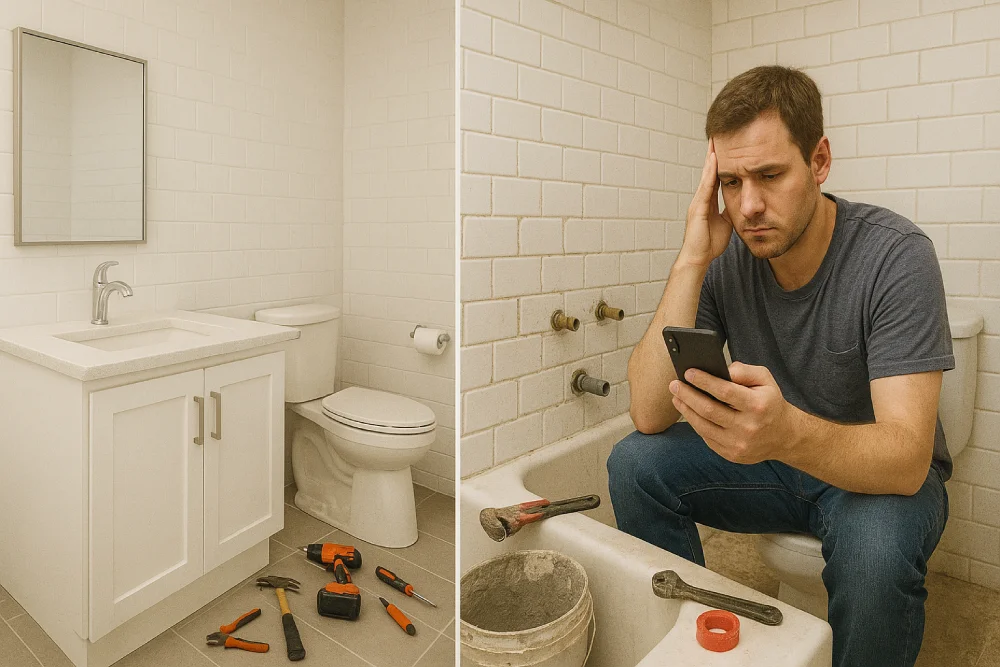
DIY remodeling can save 20-30% on costs but risks amateur quality and potential rework expenses. Professional contractors complete projects 2-3 times faster with warranty-backed, code-compliant results. Simple tasks like painting suit DIY enthusiasts, while complex renovations benefit from professional proficiency. Homeowners must weigh immediate savings against long-term satisfaction and property value. The right approach depends on project scope, personal skill level, and time availability.
When homeowners consider remodeling projects, the cost equation presents significant intricacies beyond simple contractor quotes versus DIY estimates. While DIY approaches eliminate labor fees of $70-$130 per hour, they introduce tool rental expenses ranging from hundreds per project and potential material waste from inexperience.
A strategic material procurement strategy impacts overall budgets substantially. DIY enthusiasts can save 20-30% through reuse stores and direct purchasing, avoiding contractor markups of 15-30%. However, material scarcity considerations arise when relying on salvaged supplies, which may delay projects or compromise design consistency. DIY projects can result in costly mistakes that require professional intervention to correct, eliminating any initial savings.
Professional contractors offer efficiency through specialized tool access and wholesale material pricing, but often include markup structures exceeding retail costs. The financial calculation ultimately weighs DIY time investment against professional know-how and warranty assurances. Projects involving electrical work should always be left to professionals due to significant safety hazards and complex code requirements. Full-service design-build partnerships typically deliver more transparent pricing certainty early in the process, reducing unexpected costs from change orders during construction.
The ultimate measure of any home improvement project extends beyond initial expenses to the quality of finishing touches and overall craftsmanship. While DIY enthusiasts may save money upfront, professional contractors typically deliver precision, durability, and code-compliant outcomes that enhance property value over time. Homeowners must weigh immediate satisfaction against long-term investment returns when deciding whether skill development or professional competence better serves their renovation goals. Professional contractors provide unrivaled quality and top-notch craftsmanship that often justify their higher costs through superior finished results.
While many homeowners focus on the broad strokes of a renovation project, finishing touches ultimately determine long-term satisfaction and value. Professional contractors excel at aesthetic consistency in details like color matching and uniform finishes that DIY projects often struggle to achieve.
Professionals leverage precision tools and techniques that create seamless transitions between spaces, avoiding uniformity concerns like patchy paintwork or mismatched flooring. Their skillset translates creative vision into functional, polished environments where materials and spacing are coordinated for optimal flow.
Warranty-backed professional work eliminates post-renovation stressors and typically results in higher client satisfaction regarding both comfort and functionality. Though DIY projects may offer initial savings, the polished finishing touches provided by professionals create spaces that align more closely with homeowners' expectations while maintaining their appeal long-term.
Determining true value in home renovations requires homeowners to balance skill quality against price considerations. While DIY projects can save up to 83% compared to professional contractors, these savings must be weighed against quality outcomes and potential limitations.
Professionals deliver code-compliant, aesthetically superior results with specialized knowledge, proper permits, and warranty protection. DIY efforts may suffer from amateur techniques and suboptimal finishes, particularly in complex projects. A realistic planning timeline includes calculating the opportunity cost of DIY hours versus professional effectiveness.
Before proceeding, a thorough skill level assessment helps identify whether a project aligns with personal capabilities. Simple tasks like painting generally suit DIY enthusiasts, while multi-trade renovations benefit from professional coordination. Ultimately, the value equation balances immediate financial savings against long-term quality, safety, and time investment.
Assessing long-term value in home renovations extends beyond immediate costs to encompass quality outcomes that influence owner satisfaction for years ahead. Professional contractors deliver superior craftsmanship through specialized skills and high-grade materials, resulting in finishes that maintain aesthetic appeal and structural integrity over time.
While DIY projects might save money initially, professionally executed renovations typically offer greater value retention through proper installation techniques and adherence to building codes. Contractors' work withstands daily wear better, minimizing repeat repairs that plague hastened DIY fixes. Additionally, professional renovations provide significant resale advantages—potential buyers consistently favor code-certified upgrades with proper documentation and warranty coverage. The climate-specific durability considerations professionals implement further protect the investment, as materials and methods are deliberately chosen to resist regional weather patterns and usage demands.
The time commitment represents one of the starkest contrasts between DIY remodeling and professional contracting. Professional contractors typically complete projects two to three times faster than homeowners due to specialized workflows, full-time focus, and immediate response to unexpected events.
DIYers face significant schedule challenges, with weekend-only availability extending bathroom renovations to 3-6 months versus 4-8 weeks for contractors. This timeline disparity increases with project complexity, as homeowners must traverse permits, inspections, and material deliveries independently. The risk tolerance of DIYers is tested through learning curves and hidden time costs—hours spent researching building codes, troubleshooting mistakes, and developing new skills. Meanwhile, contractors utilize industry connections to expedite permits and maintain momentum through coordinated subcontractor scheduling, providing clearer timelines and minimizing project downtime.
When evaluating renovation projects, understanding which types naturally align with DIY versus professional approaches saves homeowners both time and money. Project scope impacts the feasibility of self-completion, with cosmetic updates and minor repairs generally suitable for DIY enthusiasts possessing basic skills and tools.
Simple projects like painting, decorative shelf installation, and cabinet hardware replacement offer low-risk entry points for homeowners with budget constraints. However, as renovations involve structural alterations, specialized technical systems, or regulated work, professional contractors become essential rather than optional. Even experienced DIYers should avoid electrical rewiring, plumbing reconfigurations, and load-bearing modifications due to safety concerns and permit requirements.
Budget constraints influence these decisions significantly, as cosmetic DIY projects typically cost less than hiring professionals, while complex renovations require proficiency that ultimately saves money by preventing costly errors.
Economic factors significantly shape homeowners' decisions between DIY and professional remodeling, with current market trends showing $463 billion in Q1 2024 renovations despite recent declines. Individual household income determines project scope and approach, with higher-income homeowners more likely to hire professionals for extensive renovations while budget-conscious consumers favor DIY for cost control. Rising material costs and labor expenses create challenging tradeoffs between quality and affordability, prompting many homeowners to strategically combine DIY efforts with targeted professional services for optimal value.
As household income rises, home improvement decisions shift dramatically from necessity to discretion, with data showing each $1,000 income increase generates $25.44 in additional remodeling spending compared to just $2.29 for maintenance. This economic segmentation reveals distinct discretionary spending patterns across income brackets.
The data highlights several key patterns:
This income-driven scaling explains why the remodeling market reached $603 billion in 2024, revealing how financial capacity shapes project ambitions.
Market conditions fundamentally reshape the calculus between DIY and professional remodeling approaches, with nearly every economic indicator influencing homeowner decisions. Labor availability fluctuations directly affect contractor pricing and project timeline management, while material cost volatility impacts budget predictability for both approaches.
Economic expansions typically favor professional contractors as housing market strength increases renovation demand, though competitive markets may strain contractor availability. Simultaneously, tariffs on imported materials disproportionately burden DIY projects without established supply networks. Regulatory compliance requirements for specialized trades often necessitate licensed professionals, limiting DIY feasibility for complex installations.
Material accessibility improvements benefit both approaches, yet contractors maintain advantages through established bulk purchasing relationships. During economic uncertainty, DIY projects may offer cost control, while contractor warranties provide advantageous risk mitigation absent in self-directed renovations.
The financial calculus of remodeling introduces stark budget versus quality tradeoffs that homeowners must maneuver. When comparing DIY approaches to professional contracting, initial cost advantages often mask long-term quality impacts that affect property value and satisfaction.
The real calculation extends beyond upfront expenses to include project longevity, marketability, and long-term maintenance requirements.
Beyond immediate hazards, regulatory compliance issues loom large. Unpermitted work can trigger municipal fines, void insurance coverage, and create stakeholder liability extending beyond the homeowner to affect neighbors and future buyers. The financial calculus shifts dramatically when considering that improperly executed work frequently requires professional correction, sometimes at greater expense than hiring professionals initially. This compounds with time lost and potential property devaluation from substandard workmanship.
The decision between DIY remodeling and hiring professional contractors hinges on personal priorities. DIY offers cost savings and satisfaction but demands significant time and skill. Professional work, such as that provided by TriStar Built, ensures quality craftsmanship, adherence to building codes, and project efficiency—though typically at a higher cost. Homeowners should realistically assess project complexity, budget constraints, and long-term value when choosing their approach. The optimal choice ultimately balances financial considerations with desired outcomes and risk tolerance.
DIY skills frequently transfer to maintenance tasks, enhancing problem-solving abilities, tool proficiency, and time management. These transferable skills can increase home equity and provide improved curb appeal through consistent property upkeep.
Insurance policies typically exclude DIY work, creating liability concerns for homeowners. Contractor work shifts risk to professional policies, requiring verification of coverage and protecting homeowners from unauthorized or substandard renovations.
Beginning DIYers should prioritize versatile basics: measuring tape, screwdriver set, hammer, and level. Power tool selection should start with a quality drill. Project organization tools like clamps complete the essential foundation.
Contractors typically employ material waste recycling options for concrete, asphalt, and metals while utilizing efficient disposal methods through specialized facilities. Lower-value materials often go to landfills based on cost and convenience considerations.
Remodeling trends vary significantly by region, influenced by regional housing styles, climate considerations, and local material availability. Coastal areas favor weatherproofing while historic districts prioritize preservation of design elements.

Whether you’re remodeling a home, expanding a business, or starting from the ground up, TriStar Built is here to guide you every step of the way. With a focus on craftsmanship, communication, and results that last, we make the construction process clear, smooth, and worth every investment.

LOCATION: 2126 James Street, Denton, TX 76205
PHONE: (940) 381-2222
© 2025 TRISTAR BUILT - ALL RIGHTS RESERVED | WEB DESIGN & SEO BY: Authority Solutions®